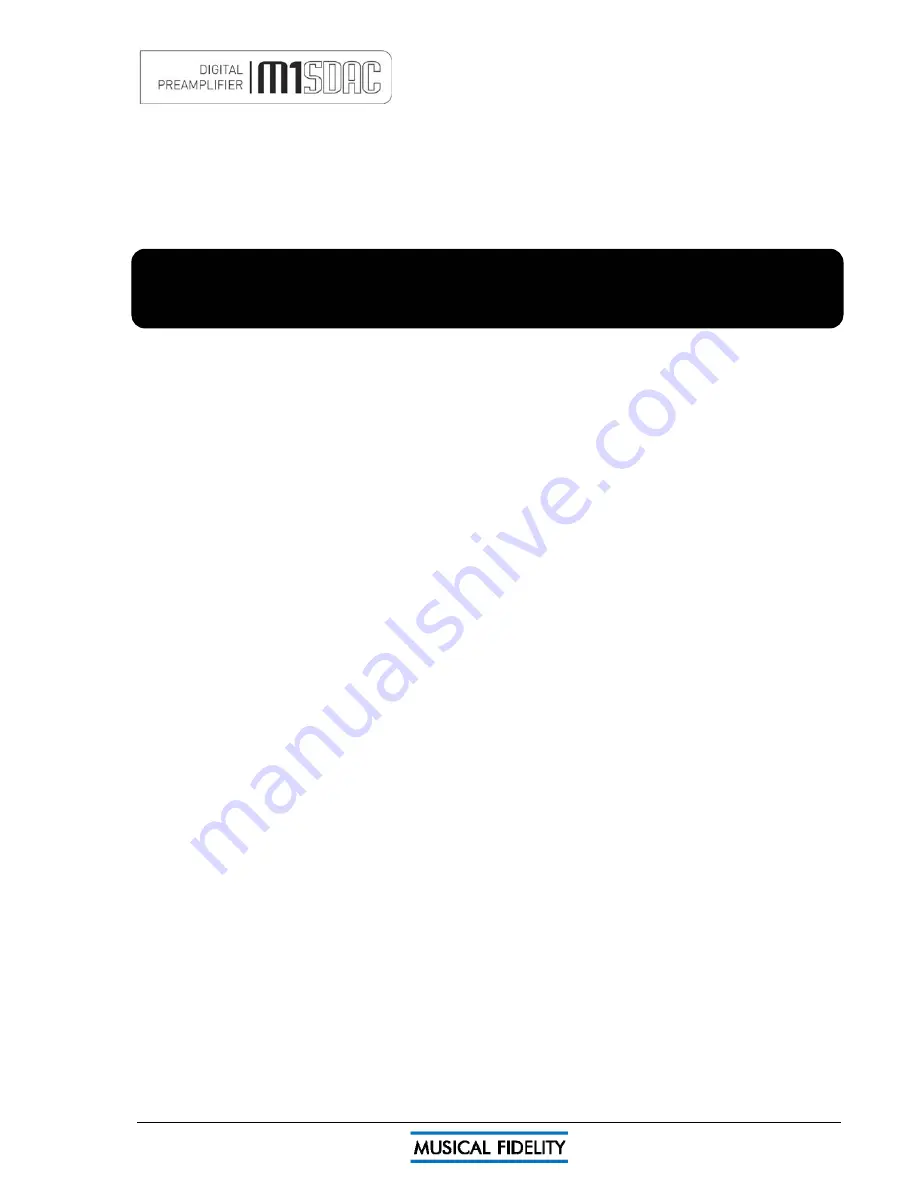
INSTALLATION
Issue 4
Page 7 of
47
Introduction
Congratulations on the purchase of the new M1 SDAC. This unit will deliver the ultimate performance possible
from any digital source. It is designed to upgrade CD players, TVs, set-top-boxes, DAB tuners, and any other
source providing a variety of digital outputs.
Installation
Position the M1 SDAC on a stable, horizontal surface where there is no risk of it being knocked, or subjected to
vibration such as from loudspeakers.
Important note: In normal operation, the unit dissipates a small quantity of power at all times, and it is
important that it is adequately ventilated. The M1 SDAC must be protected from humidity – if the unit is
moved from a cold place to a warm room, leave the unit for an hour or so to allow sufficient time for the
moisture to evaporate.
Power Connections
The M1 SDAC is supplied with a standard IEC mains cable which plugs into the IEC socket at the back of the
unit.
Audio input connections
RCA audio inputs AUX 1, AUX 2:
Use good quality shielded RCA phono audio cables (fully connected at both
ends - signal
and
ground), for optimum signal transfer.
Audio output connections
RCA audio outputs:
Use good quality shielded RCA phono audio cables (fully connected at both ends - signal
and
ground), for optimum signal transfer.
HEADPHONES output:
Use good quality headphones for private listening.
Digital input connections
COAXIAL inputs:
Connect RCA digital source to digital input RCA sockets 1, 2 or both. Use a good quality fully
connected (signal and ground) coaxial digital cable, for optimum signal transfer.
AES BALANCED input:
Connect AES/EBU digital source to balanced digital input XLR socket. Use a good
quality balanced DIGITAL cable, for optimum signal transfer. Recommended wiring is given on P.7
OPTICAL input:
Connect optical digital source to optical input socket. Use a good quality “Toslink” cable, for
optimum signal transfer.
Note: If connecting to Home Theatre Processor, TV or DVD, Blue-Ray, or similar Home Theatre digital
sources
,
it may be necessary to change the digital output of the
source
to
“16 bit stereo PCM
”, or similar, which
is the format the M1 SDAC will understand. Please refer to the
source’s
manual for information on how to do
this. The M1 SDAC does not recognise the information in multichannel (surround sound) digital audio streams.
USB input:
Connect computer or similar USB “host” source to USB input socket. Use a good quality
USB 2.0
“A to B” type cable (not supplied), for optimum signal transfer. Try to keep USB cable length to a minimum for
best reliability. The USB 2.0 standard maximum for a single cable is 5M, after which repeaters (normally mains-
powered USB hubs) are required. We do however; recommend
avoiding
such a setup if at all possible and
keeping the USB lead length to the absolute minimum possible for the setup.
Digital output connections
COAXIAL output:
Connect RCA digital receiver or digital recording device to digital output RCA socket. Use a
good quality fully connected (signal and ground) coaxial digital cable, for optimum signal transfer.
OPTICAL output:
Connect optical digital receiver or digital recording device to digital output optical socket. Use
a good quality “Toslink” cable, for optimum signal transfer.
Trigger Connections
Trigger input:
Connect system triggering device output to this socket. Use good quality 3.5mm mono jack
cable. Unit accepts 4.5V-15V DC triggering, either polarity.
Trigger output:
Connect further devices in the system to be triggered into this socket. Use good quality 3.5mm
mono jack cable. Unit passes on +12V DC at up to 60mA, for further devices.
Interconnects
Please note:
Musical Fidelity
currently do not make any interconnecting cables other than those supplied with
the unit.
Musical Fidelity
does not endorse any other manufacturer’s cables.
If necessary, please refer to the dealer who can advise on quality cables for any particular setup.
Summary of Contents for M1 SDAC
Page 2: ......
Page 29: ...DRIVER UNINSTALL WINDOWS XP Issue 4 Page 29 of 47 Click Finish Driver removal is now complete ...
Page 36: ...UNINSTALL WINDOWS VISTA 7 Issue 4 Page 36 of 47 Click Finish Driver removal is now complete ...
Page 44: ...Issue 4 Page 44 of 47 For listening thoughts and observations ...
Page 45: ...Issue 4 Page 45 of 47 For listening thoughts and observations ...
Page 46: ...Issue 4 Page 46 of 47 For listening thoughts and observations ...
Page 47: ...Issue 4 Page 47 of 47 For listening thoughts and observations ...







































